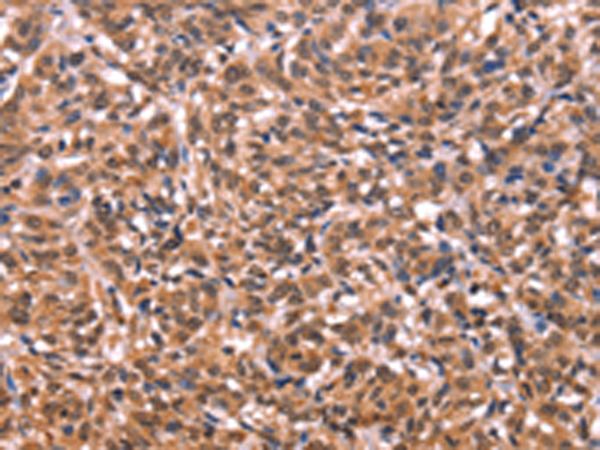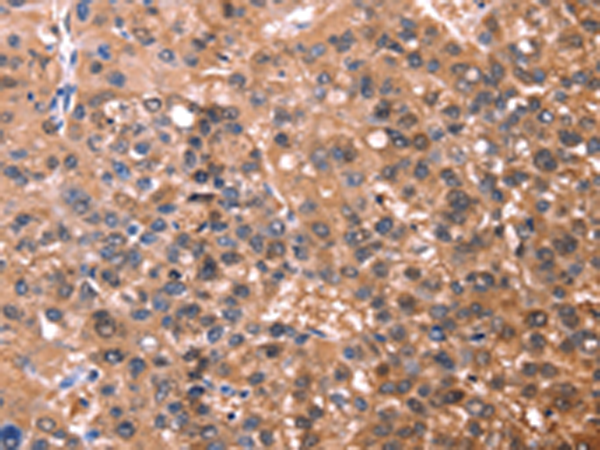

| WB | 咨询技术 | Human,Mouse,Rat |
| IF | 咨询技术 | Human,Mouse,Rat |
| IHC | 1/50-1/200 | Human,Mouse,Rat |
| ICC | 技术咨询 | Human,Mouse,Rat |
| FCM | 咨询技术 | Human,Mouse,Rat |
| Elisa | 1/2000-1/5000 | Human,Mouse,Rat |
| Aliases | ERR2; ERRb; ESRL2; NR3B2; DFNB35 |
| Host/Isotype | Rabbit IgG |
| Antibody Type | Primary antibody |
| Storage | Store at 4°C short term. Aliquot and store at -20°C long term. Avoid freeze/thaw cycles. |
| Species Reactivity | Human |
| Immunogen | Synthetic peptide of human ESRRB |
| Formulation | Purified antibody in PBS with 0.05% sodium azide and 50% glycerol. |
+ +
以下是关于ESRRB抗体的3篇参考文献及其摘要概括:
1. **"Esrrb is a pivotal target of the Gsk3/Tcf3 axis regulating embryonic stem cell self-renewal"**
- **作者**: Martello, G., et al.
- **摘要**: 研究通过ESRRB抗体进行染色质免疫沉淀(ChIP)实验,发现ESRRB是小鼠胚胎干细胞自我更新的关键调节因子,其表达受Wnt/β-catenin信号通路调控,并与多能性网络中的OCT4和NANOG协同作用。
2. **"Esrrb activation by converting naive pluripotency to primed pluripotency"**
- **作者**: Festucco, N., et al.
- **摘要**: 该研究利用ESRRB抗体进行免疫荧光和Western blot分析,揭示ESRRB在将小鼠胚胎干细胞从“初始态”多能性转化为“启动态”多能性过程中的动态表达变化,并证明其通过调控下游代谢相关基因维持多能性。
3. **"Esrrb is required for mouse trophoblast stem cell self-renewal"**
- **作者**: Adachi, K., et al.
- **摘要**: 通过ESRRB抗体的功能阻断实验,研究发现ESRRB在小鼠滋养层干细胞(TSCs)的自我更新中不可或缺,其缺失导致干细胞分化标志物丢失,并影响胎盘发育相关基因的表达。
以上研究均通过ESRRB抗体的实验手段,揭示了该转录因子在干细胞多能性和分化中的关键作用。
ESRRB (Estrogen-Related Receptor Beta) is a nuclear receptor transcription factor belonging to the NR3B subfamily. It plays critical roles in embryonic development, placental formation, and the maintenance of pluripotency in embryonic stem cells (ESCs). ESRRB regulates target genes by binding to specific DNA response elements, often in coordination with co-activators like PGC-1α. Structurally, it contains a DNA-binding domain (DBD) and a ligand-binding domain (LBD), though its endogenous ligand remains unidentified. Notably, ESRRB is a core component of the regulatory network sustaining ESC self-renewal, interacting with key pluripotency factors such as OCT4. NANOG, and SOX2. It also contributes to cellular reprogramming, where its overexpression enhances induced pluripotent stem cell (iPSC) generation.
ESRRB antibodies are widely used to study its expression, localization, and function in developmental biology, regenerative medicine, and cancer research. These antibodies enable techniques like Western blotting, immunofluorescence, chromatin immunoprecipitation (ChIP), and flow cytometry. Dysregulation of ESRRB has been implicated in cancers (e.g., prostate, breast) and placental disorders, making its detection crucial for understanding disease mechanisms. Validation of ESRRB antibodies includes testing in knockout cell lines and verifying specificity for its ~50 kDa protein band. Researchers rely on these tools to explore ESRRB's role in gene regulation, stem cell dynamics, and potential therapeutic applications.
×